Second Life is the global creative context for key debates about the future of virtual worlds. Chris Renaud, notes the China and Entropia deal could be a game-changer. But, this evolving role of Second Life as a global virtual institute of the future may be a game-changer too.
Second Life is creating the kind of linking back from virtual to real worlds that will drive virtual worlds to be even more highly valued, and “people to find and create more value because of this linking” (see the manifesto for Flickr).
There has been a lot of excellent high powered commentary on the future of Second Life and Virtual Worlds in general recently, see Chris Renaud’s Weblog, Mark Wallace on 3pointD, and IBM vice president of standards and open source Bob Sutor who has done a series of posts. So, it takes a little audacity to pipe up with some more commentary!
But, Second Life seems to have become the de facto Virtual Institute For The Future regardless of the scaling challenges supernova growth has caused in recent months. And, I think this has a lot of significance. A dizzying array of world class conferences, meetups, and opportunities to interact with metathinkers, futurists, leaders in art, architecture, technology, law, education, politics, and culture are scheduled on a daily basis, often concurrently.
Gwyneth Llewelyn has just written a post that looks at the history of governance on Second Life and Linden Lab’s changing role re Second Life. But, what I am noting, and this is not just Linden Lab but organizations, corps and individuals in Second Life as well, is a growing movement to transform Second Life into a “global creative context” of the future.
Friday, I found myself in the hallowed halls of Columbia University, New York City in Real Life, attending, “The Economics and Business of Second Life and Virtual Worlds.” And, while I listened to John Lester of Linden Lab giving his presentation, “Virtual World, Real People,” I participated in the Second Life component of the iCommons Summit 2007, Dubrovnik, Croatia, which was being streamed into Second Life, on my laptop. Cory Ondrejka (also of Linden Labs) was speaking at the time.
To interact with all four levels of these two conferences being held continents apart – the two real life conferences and their virtual components – was an extremely valuable experience.
These conferences looked at two of the major forces shaping virtual worlds at the moment. Columbia focused on business and economics (law/governance, marketing, applications and national interests). And the iCommons Summit, 2007, in Dubrovnik, Croatia, is the forum developing new contexts for creativity (a global ecology of free culture). Recordings and presentations for the Columbia can be found here, and from iCommons Summit here.
“Creative Commons and Peer Production” – Second Life and Dubrovnik, Croatia
Below is the “Creative Commons and Peer Production in Second Life,” panel with Anna Berthold – USC Center on Public Diplomacy (Anna Annenberg), and Jean Miller (Jean Linden in Second Life where she and Anna have been available for interviews and questions for much of the conference), Cory Ondrejka (Linden Labs), and Chinese artist, Cao Fei (China Tracy in Second Life) is in frame in the picture at the beginning of this post. Cao Fei talked about how Second Life was a place for artistic expression that gave Chinese artists unrestricted access to an international audience. See more about China Tracy in New World Notes. NWN reviewed and posted all three parts of China Tracy’s awesome machinima art project i.Mirror here. Also see China Tracy’s blog.
Of course, there were questions on when SL will open source server side. But Cory Ondrejka was clear that with 520 new sims per week Linden Lab needs other people to host as quickly as possible. And, he commented re questions on the transaction system of Linden Dollars that while having this transaction system has been a very important part of the growth of Second Life, Linden Lab doesn’t want to be a bank. And, they are looking to partner on this.
Cory also mentioned one of the areas I have been talking about a lot on Ugotrade: How communities who have been cut off from the global economy up to this point, with recent break-throughs in broadband access, particularly wireless, are seeing the possibility of connecting to an economy that they have never had the chance to be connected to before.
The building housing the event in Croatia was a world away from The Columbia Business School (screen grab).
I will go into how peer production, creative commons, and public diplomacy (all key areas to understanding global creative contexts) are evolving with, and integral to, Second Life later in this post.
The scene at Columbia University – photo courtesy of my digital camera.
“Virtual World, Real People” – John Lester (a.k.a. Pathfinder Linden) at Columbia University, New York.
John Lester, in addition to speaking to the Real Life participants at the Columbia Conference (see presentation here), hung out as Pathfinder Linden on the IBM SOA HUB “causing trouble” (his words not mine!) with the Second Life conference participants, many of whom were noobs (recent arrivals on SL). IBM helped the Columbia Business School to put on the Second Life component of their event.
Pathfinder Linden does not appear to have gone to the newly opened lab and gotten a photo realistic face job, yet. Pathfinder introduced the audience in Real Life and Second Life to some of his many avatars on Second Life.
“Global Creative Contexts” of the Future?
The title of this post is inspired by the futurist Chris Luebkeman, the director of Arup’s Global Foresight, who gave his first talk on Second Life, last Thursdy, “Future Challenges: Global Creative Contexts.” Chris Luebkeman (a.k.a. Luebke Mannonen on Second Life) spoke on Autodesk Island HERE (SLurl). It was a real thrill to see someone who is, “tasked with exploring and synthesizing the trends affecting society’s development” in real life, getting excited by Second Life.
I heard the excitement in Chris’s voice when he described the experience of working with the Clear Ink and Autodesk and Keystone Bouchard:
seeing while we were talking, architecture and space created right in front of me with me being a participant – the equivalent of being in a bar and drawing on a napkin – the power to convey concept intent and meaning. Where that will go? I can’t wait to explore that medium…..
Keystone desribes the event in some detail here:
The event started with Chris (avatar Leubke Mannonen) and Autodesk moderator RevitQueen Oh sitting on top of a virtual replica of the Drivers of Change box that typically serves as a give-away during real-life presentations. In this case, the box contained a HUD, created by Kiwini Oe of Clear Ink, that enables visitors to read more about each category.
I see Chris’s arrival on Second Life as a very special occasion. An architect who has taken up the challenge of global planning – a new composer is becoming engaged with Second Life.
The “jumping off point” slogan for the Flickr, in “Transcendent Interactions manifesto” is:
Don’t build applications build contexts for interaction.
So it is in light of both the Jon Jerde entertainment enclosure and the new model of relationship-based computing that we begin to understand the monolithic entrapment that heavily branded MMOGs and closed social software applications represent.
The real action of inter-relation happens in the spaces between these monolithic structures. Play, improvisation, and communication don’t need containers, they need platforms.
The new composers of these platforms are more like urban planners than architects.
Play between between avatar and identity are vital to the emotional bandwidth of Second Life.
Click on this screen grab to see a stunningly beautiful clip from Pierce Portocarrero who is experimenting with Christian Prior, and SnoopyBrown Zamboni in using the camera control programing inside of SL to create a more cinematic experience of Second Life.
Pierce P. is creating a language of possibility for machinma that expresses the power of the experience of Second Life.
Identity Play and Authenticated ID
One of the most interesting questions re the future development of virtual worlds is how identity play will change as virtual worlds are increasingly linked back to real worlds. Identity play has been a driving force in the early development of Second Life. The arrival of brands, commerce in particular, and increased attention to transactions in virtual economies has brought a new impetus to moves to authenticated ID – linking an online identity with a physical one – on Second Life. This increased linking of identity will also strengthen the relationship between law in real life and virtual life. The main point that came across from the legal speakers at the Columbia was that legal issues re virtual worlds – property issues and money laundering and other issues were evolving with this increased linkage.
But, there is speculation that as Second Life becomes further linked back to real life what might be sacrificed is the opportunities to play with identity and the emotional bandwidth that has energized the miracle of creation of this first great immersive user generated virtual world.
Ren Reynolds, (a.k.a Renzephyr Zircon on Second Life) has proposed on Terranova a Four World Theory:
- ludic-worlds (aka game-worlds)
- social-worlds
- civil-worlds
With our geographic world being a fourth, a common context in which these sit (so it’s the Three World Theory with the geographic one tacked on)
I was fortunate enough to meet Ren Reynolds on Second Life Saturday night, and to hear his thoughts directly. Ren, a friend he was introducing to Second Life for the first time, Aleister Kronos and I met (fully clothed) in a hot tub/hot cup of coffee for a chat. The discussion ranged from our varying desires and non desires for alt gender avatars to the multi billion dollar question that Al plopped out into the rising steam.
What’s your “take” then Ren [on left] – on SL and its ramifications for the next N years
Ren explained (after a little repartee with Al):
I think that SL will move from the Social status to the Civic status in that identity play will reduce as brands come in and authenticated ID – the idea of linking an online identity with a physical – will become more important. In the EU it will fall under the e-currency directive within 5 years.
We also talked about “the possibility that different virtual worlds will one day support a standard that would let users travel freely among them.” Ren suggested that with the transfer of identity should be the idea of this being permissions based so that one can opt for multiple identities and the degree that they are linked to others. Ren has written at length about this elsewhere.
As I was writing this post I twittered some questions and, the twitter streams of ![]() deeeepwitte,
deeeepwitte,  timbok28 both came back with a stream of interesting micro-blogged thoughts on linking the real/virtual and identity across mutliple metaverses (Sunday June 17th).
timbok28 both came back with a stream of interesting micro-blogged thoughts on linking the real/virtual and identity across mutliple metaverses (Sunday June 17th).
The President’s Daily Game
What kind of avatar Ruth M. Bush, Division Chief, Information Exploitation Division, Disruptive Technology office, Office of the Director of National Intelligence wears was not revealed at the Columbia Conference. But, Ruth gave us the heads up that she is not a spy.
She recommended, to understand virtual worlds better, we should read, “The Innovation Dilemma,” by Clayton Christensen about changes in basic business model that are a revolution not evolution – these are called “disruptive” technologies. The Intelligence Communities Information Exploitation division has its own Intellipedia Wiki project and they are very interested in the immersive context and massively multi-user environments, identity and the use of “disruptive technologies,” i.e. virtual worlds.
Oh and brace yourself. Ruth mentioned that The President’s Daily Brief might instead be The President’s Daily Game. I twittered this and got this response:
 HiroPen @Ugotrade the Pres already has a MMOG. It’s called “American Usurper”. *sigh*
HiroPen @Ugotrade the Pres already has a MMOG. It’s called “American Usurper”. *sigh*
iCommons Summit 2007.
Some of the magic of attending a conference in Second Life happened when Rik Riel got a question through to Dubrovnik and an answer back.
Rik has blogged and posted:
a quick video of Jonathan Zittrain answering a question I posed to him from Second Life. Namely: How do we win the fight for free culture when the hardware / OS layer is being increasingly locked down by Microsoft and Apple for freely creating, sharing and re-mixing our content?
It is really is a thrill to be able to be an active participant in these world scale and world changing events in this way. Rik Riel has also blogged another significant event that I attended last week – the Second Life component of The Game 4 Change Conference.
iCommons Summit on Second Life in Pictures
Here are some of the great pictures that can be found on the page Sitearm Madonna has created. The captions are by Sitearm too. These pictures tell the story of an extraordinary event. Here are just a few of them. The are licensed Creative Commons Attribution 3.0. Share, Remix OK
SJ KLEIN describes the One Laptop Per Child Project. A savvy SL resident promptly asked Cory Linden, also on the panel, “would Second Life run on the laptop Mr. Klein describes.” Answer? “Um.. no.. but soon!”
WIKIPEDIA FAN Wellington Bahram chats with Wikipedia Founder Jimmy Wales, present in world as avatar Jimbo Berkman.
CORY, YOU LOOK MARRVELLOUS! The sharp-looking avi in blue and black is Cory Linden, Chief Technology Officer of Linden Lab. And above him is ALSO Cory Linden, visible on vid stream simulcast from Croatia. Yes, RL Cory IS looking at his laptop, admiring SL Cory o..O)
Cory answered questions about the way creative commons is, in Second Life, in the object ownership where it is aligned with permissions and therefore on the level of technology. The questioner noted that creative commons is supposed to be expressive and wanted to know whether this be implemented on Second Life. Cory agreed this would be a good idea. But the discussion didn’t go much further on this.
But, as Mia Garlick wrote:
In a very real sense, Second Life exists as it does because of Lawrence Lessig [founder and CEO of the Creative Commons]. A few years ago, he advised Linden Lab to allow their subscribers to retain IP rights to whatever they built. The result of this has been an explosion of sustained creativity, with many Residents making all or some of their real life living by their imagination and efforts in SL.
Good Copy Bad Copy” by Henrik Moltke was screened in world (also available on the web here). The movie documents the status of copyright and culture. Also the visionaries of Creative Commons, Yochai Benkler who writes about the emergence of networked economy and society, and Larry Lessig, Free Culture (2004) are interviewed. They explain how participatory culture is winning in the social, cultural and technological spheres (ironically with some big corporations blazing a trail here, e.g. IBM, Sun and HP), even while the conservative forces of “old media” continue to win in court.
Public Diplomacy was also a key topic at iCommons, and how Second Life was a significant application for this, and can be used to facilitate inter-cultural dialogue.
Public Diplomacy is one of those terms that (at least for me) needs some unpacking. Sitearm Madonna described it nicely as, “how one country relates to THE CITIZENS of another country. And, at its best public diplomacy is authentic communication from citizen to citizen.
Sitearm Madonna was present in-world throughout the conference. She has been working with USC Center on Public Diplomacy. Sitearm built the exhibition area, scheduled the concerts and mixers, and worked closely with the icommons organization to create a parallel conference as in-world producer of the in-world conference, doing the in-world event promotion, production and co-ordination. Sitearm and her team did an impressive job. And, as there are regular SL get-togethers planned to translate the knowledge gained at the conference into practicality, there should be many more opportunities to visit and participate in iCommons events on Annenberg Island.
Extra!
Ugotrade Junior turns 8 this week. And, I proudly attended his 2nd grade publishing party. This is the photo he took of the cover of his book, “Wonder Pets Save The Day.”
Tags: Second Life | Virtual Worlds | Virtual Reality | Creative Commons | Peer production | iCommons | iCommons Summit 2007 | Larry Lessig | Cory Ondrejka | Web 2.0 | Web 3pointD | Jimmy Wales | Wikipedia | Intellipedia | Pierce P. | Pierce P. Portocarrero | machinima | Christian Prior | Snoopy Brown Zamboni | Games 4 Change | Rik Riel | Public Diplomacy | Sitearm Madonna | Annenberg Island | Autodesk Island | Free Culture | Yochai Benkler | Good Copy bad Copy | participatory culture | disruptive technologies | authenticated ID | open standards for virtual worlds | metaverse | multiverse | multiple metaverses | Transcendent Interactions | relational Computing | Chris Luebkeman | global creative contexts | drivers for change | China and Entropia | Entropia | future of virtual worlds | |

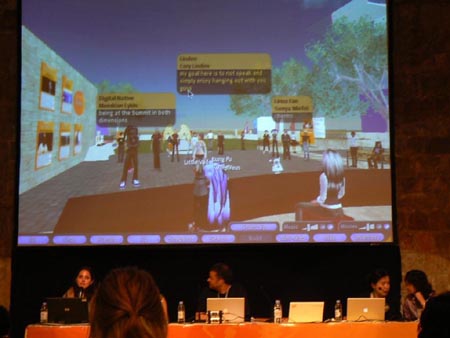
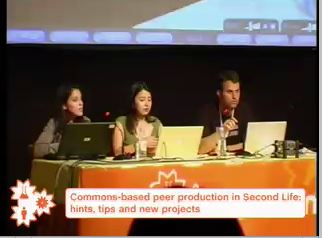
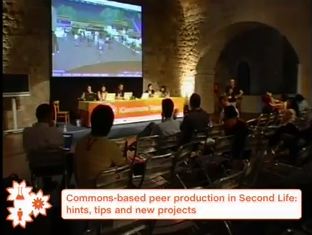
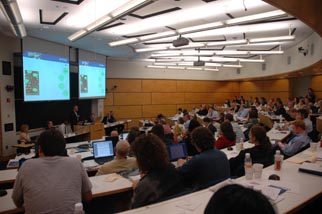

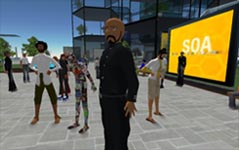
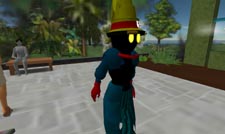
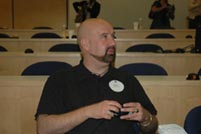
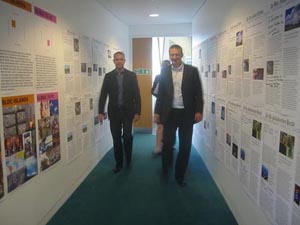
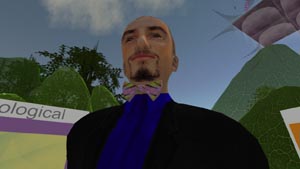


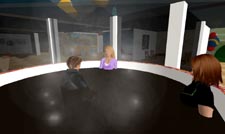
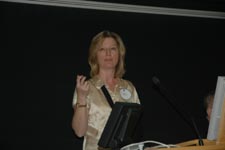


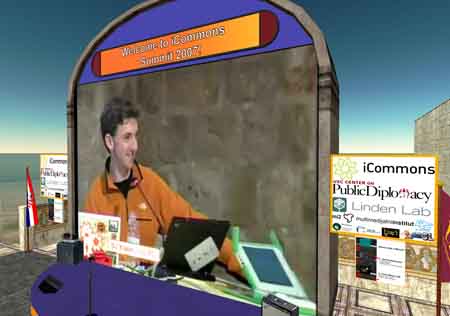
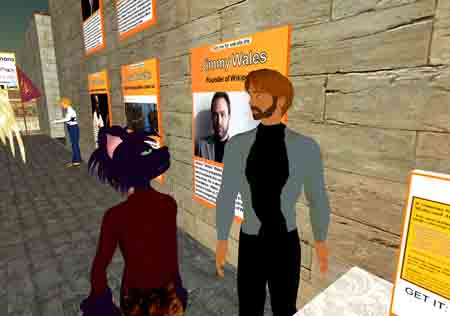
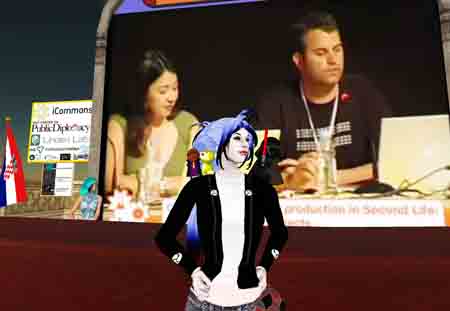


June 18th, 2007 at 5:24 pm
Tish, as always another excellent top of the bill post.
YES! Second Life might be a gamechanger, despite what criticasters say. Second Life is getting more media attention than any other NGE, and that’s not only because of hype-cycles. It is because Second Life is the ultimate crowdsourcing platform when it comes to usability testing, more open than any other Metaverse at this point. So yeah, they’ll be in the frontline when it comes to hiccups on the road to web 3D, but that is acceptable as long as it remains a forerunner of innovation and YOU-platform.
We’re sailing unchartered waters for most of it though.